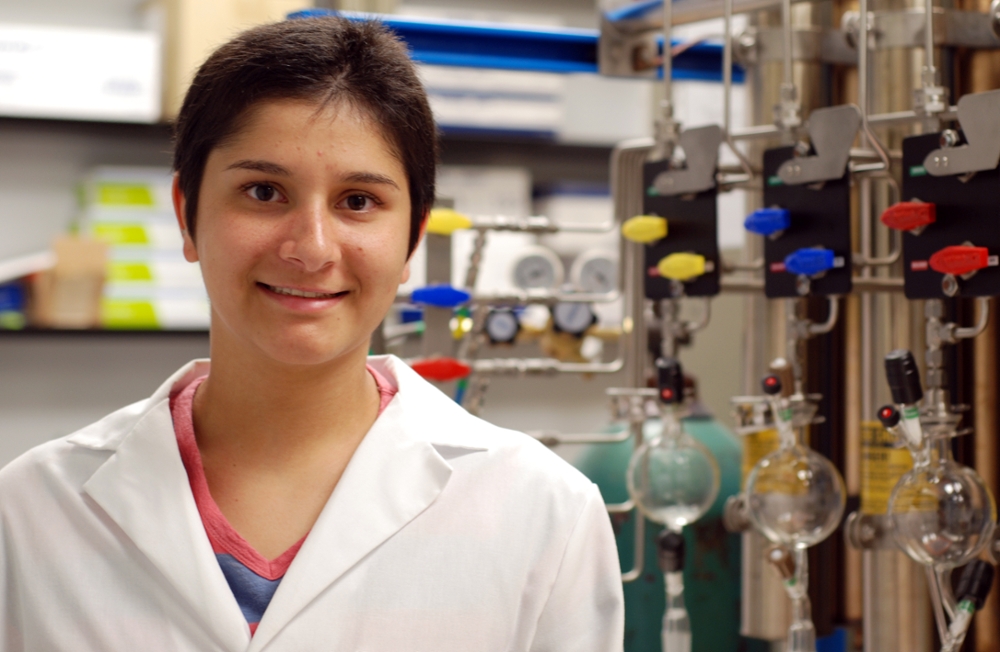COSAM News Articles 2014 November COSAM sophomore’s presentation earns top honors at regional conference
COSAM sophomore’s presentation earns top honors at regional conference
If Natasha Narayanan’s performance at the 2014 Southeast Regional Meeting of the American Chemical Society is any indication of what lies ahead in her academic and professional career, she is headed toward a consummate future. Narayanan, a COSAM sophomore and Honors College student majoring in biochemistry, gave an oral presentation titled, “Streamlined Chemical Synthesis of Tricyclic Nucleic Acid Analogues for Antisense Technology” during the undergraduate symposium portion of the conference. In recognition of both her research and eloquence, Narayanan’s talk was selected as the best oral presentation in the organic chemistry division out of 60 total presenters.
“I gave a presentation over the summer at Auburn because I was in the Cellular and Molecular Biosciences Undergraduate Summer Research Scholars program, and I was working on the same research project that I presented at the conference, so I was probably less nervous than I would have been if I hadn’t of given that talk. The practice last summer definitely helped,” said Narayanan. “I tried to explain everything in a way that anyone could understand, even without having an extensive background in organic chemistry.”
The Cellular and Molecular Biosciences program at Auburn sponsors Undergraduate Summer Research Scholars, a program that provides talented undergraduate students an opportunity to conduct research during the summer with a CMB faculty member. Narayanan was accepted to the program and worked with Bradley Merner, assistant professor of organic chemistry, conducting research in an area called “antisense technology.”
“Most genetic diseases are caused by proteins, and traditional medicines that are used to treat these diseases target the protein itself. In antisense technology, instead of targeting the protein, you target the messenger RNA that codes for the protein,” explained Narayanan. “Basically, these antisense strands are made up of repeating units called nucleotides, and we come up with a complimentary strand that will bind to the messenger RNA and prevent translation. Instead of making a drug to combat the protein, we are preventing the protein from developing in the first place. Specifically, what I am doing is creating chemically modified nucleosides that will be incorporated into the complimentary strand to increase its thermal stability when bound to the messenger RNA.”
Narayanan said she wouldn’t have even gone to the conference, which took place in Nashville, had it not been for the encouragement and mentorship she has received from Merner.
“He took a leap of faith with me by allowing me to conduct research in his lab this past summer because I had not yet taken organic chemistry,” said Narayanan. “I am taking organic chemistry this semester, and now he is teaching me things in his lab that have helped in the class.”
In addition to continuing her research efforts with Merner, in her spare time Narayanan volunteers with the Study Partners program at Auburn tutoring biology and chemistry students, and enjoys horseback riding at Sandy’s Stables in Opelika. In the future, she plans to attend graduate school and pursue a career as a chemist conducting research.
“Natasha is an exceptionally talented student,” said Merner. “Her motivation, dedication, and mastery of time management in the lab and classroom has led to an impressive nine months of research.”
Latest Headlines
-
04/17/2024
-
04/12/2024
-
04/02/2024
-
04/02/2024
-
04/02/2024

